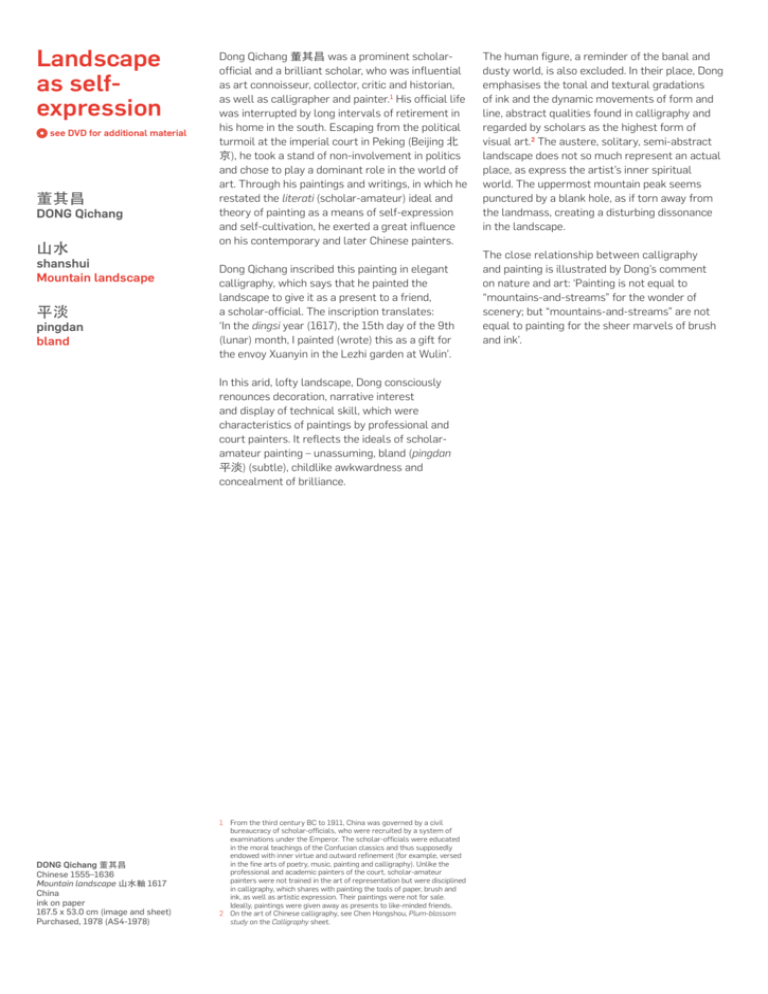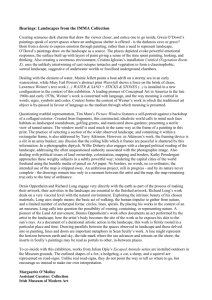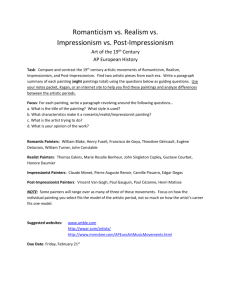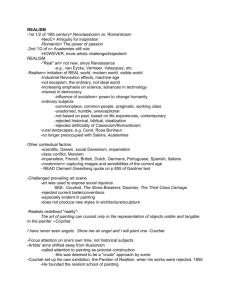Landscape as self-expression This is an early landscape painted
advertisement

Landscape as selfexpression see DVD for additional material 董其昌 Dong Qichang 山水 shanshui Mountain landscape 平淡 pingdan bland Dong Qichang 董其昌 was a prominent scholarofficial and a brilliant scholar, who was influential as art connoisseur, collector, critic and historian, as well as calligrapher and painter.1 His official life was interrupted by long intervals of retirement in his home in the south. Escaping from the political turmoil at the imperial court in Peking (Beijing 北 京), he took a stand of non-involvement in politics and chose to play a dominant role in the world of art. Through his paintings and writings, in which he restated the literati (scholar-amateur) ideal and theory of painting as a means of self-expression and self-cultivation, he exerted a great influence on his contemporary and later Chinese painters. Dong Qichang inscribed this painting in elegant calligraphy, which says that he painted the landscape to give it as a present to a friend, a scholar-official. The inscription translates: ‘In the dingsi year (1617), the 15th day of the 9th (lunar) month, I painted (wrote) this as a gift for the envoy Xuanyin in the Lezhi garden at Wulin’. In this arid, lofty landscape, Dong consciously renounces decoration, narrative interest and display of technical skill, which were characteristics of paintings by professional and court painters. It reflects the ideals of scholaramateur painting – unassuming, bland (pingdan 平淡) (subtle), childlike awkwardness and concealment of brilliance. DONG Qichang 董其昌 Chinese 1555–1636 Mountain landscape 山水軸 1617 China ink on paper 167.5 x 53.0 cm (image and sheet) Purchased, 1978 (AS4-1978) 1 From the third century BC to 1911, China was governed by a civil bureaucracy of scholar-officials, who were recruited by a system of examinations under the Emperor. The scholar-officials were educated in the moral teachings of the Confucian classics and thus supposedly endowed with inner virtue and outward refinement (for example, versed in the fine arts of poetry, music, painting and calligraphy). Unlike the professional and academic painters of the court, scholar-amateur painters were not trained in the art of representation but were disciplined in calligraphy, which shares with painting the tools of paper, brush and ink, as well as artistic expression. Their paintings were not for sale. Ideally, paintings were given away as presents to like-minded friends. 2 On the art of Chinese calligraphy, see Chen Hongshou, Plum-blossom study on the Calligraphy sheet. The human figure, a reminder of the banal and dusty world, is also excluded. In their place, Dong emphasises the tonal and textural gradations of ink and the dynamic movements of form and line, abstract qualities found in calligraphy and regarded by scholars as the highest form of visual art.2 The austere, solitary, semi-abstract landscape does not so much represent an actual place, as express the artist’s inner spiritual world. The uppermost mountain peak seems punctured by a blank hole, as if torn away from the landmass, creating a disturbing dissonance in the landscape. The close relationship between calligraphy and painting is illustrated by Dong’s comment on nature and art: ‘Painting is not equal to “mountains-and-streams” for the wonder of scenery; but “mountains-and-streams” are not equal to painting for the sheer marvels of brush and ink’.








